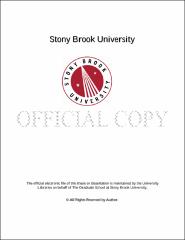| dc.identifier.uri | http://hdl.handle.net/11401/77147 | |
| dc.description.sponsorship | This work is sponsored by the Stony Brook University Graduate School in compliance with the requirements for completion of degree. | en_US |
| dc.format | Monograph | |
| dc.format.medium | Electronic Resource | en_US |
| dc.language.iso | en_US | |
| dc.publisher | The Graduate School, Stony Brook University: Stony Brook, NY. | |
| dc.type | Dissertation | |
| dcterms.abstract | Poly(diiododiacetylene) (PIDA) is a polymer consisting entirely of carbon and iodine. The polymer is prepared by cocrystallizing a bis(nitrile) oxalamide host with the monomer diiodobutadiyne. These compounds are held together by a halogen bond and an ordered 1,4-topochemical polymerization occurs in the solid state. The formation of the monomer cocrystals was found to be highly solvent dependent. Acetonitrile was found to greatly improve the yield of cocrystals over solvents used in the past. Cocrystals could not be obtained from other solvents such as dimethoxyethane and acetone. THF did give some cocrystal but the yield was poor. The use of acetonitrile as a solvent now allows for PIDA cocrystals to be reliably prepared in excellent yield for detailed studies. The weak C-I bonds in PIDA can be broken under mild conditions with simple Lewis bases like pyrrolidine and iodide ion. Studies with small molecule models show that the mechanism of elimination is E2-like and highly solvent dependent. Polar aprotic solvents favor the reaction while non-polar solvents disfavor it. Reaction occurs in protic solvents, but the rate is much slower. Iodide was found to carry out the reaction in 1 hour d5-PhNO2 while reaction with pyrrolidine did not reach completion in 15 hours. When PIDA is subjected to deiodination the product is an amorphous graphite-like material that contains non-carbon atoms. Depending on the reaction conditions, it is possible to incorporate sulfur or phosphorus into the final product. The source of these elements is the reducing agent that is typically added to sequester molecular iodine. Sequestering the iodine prevents it from reacting with the carbon species. New insights into the deiodination reaction have made PIDA more promising as a precursor to prepare all-carbon materials or heteroatom-functionalized carbon under mild conditions. | |
| dcterms.available | 2017-09-20T16:52:05Z | |
| dcterms.contributor | Goroff, Nancy S | en_US |
| dcterms.contributor | Parker, Kathlyn | en_US |
| dcterms.contributor | Grubbs, Robert | en_US |
| dcterms.contributor | Ramer, Nicholas. | en_US |
| dcterms.creator | Resch, Daniel Joseph | |
| dcterms.dateAccepted | 2017-09-20T16:52:05Z | |
| dcterms.dateSubmitted | 2017-09-20T16:52:05Z | |
| dcterms.description | Department of Chemistry. | en_US |
| dcterms.extent | 168 pg. | en_US |
| dcterms.format | Monograph | |
| dcterms.format | Application/PDF | en_US |
| dcterms.identifier | http://hdl.handle.net/11401/77147 | |
| dcterms.issued | 2013-12-01 | |
| dcterms.language | en_US | |
| dcterms.provenance | Made available in DSpace on 2017-09-20T16:52:05Z (GMT). No. of bitstreams: 1
Resch_grad.sunysb_0771E_11552.pdf: 5842087 bytes, checksum: b8b7e1f6e181d4941fd76fc4f996fcf3 (MD5)
Previous issue date: 1 | en |
| dcterms.publisher | The Graduate School, Stony Brook University: Stony Brook, NY. | |
| dcterms.subject | carbon, carbon-rich, carbyne, diiodoalkene, polydiacetylene | |
| dcterms.subject | Chemistry | |
| dcterms.title | Poly(diiododiacetylene): A Potential Precursor for New All-Carbon Materials | |
| dcterms.type | Dissertation | |

